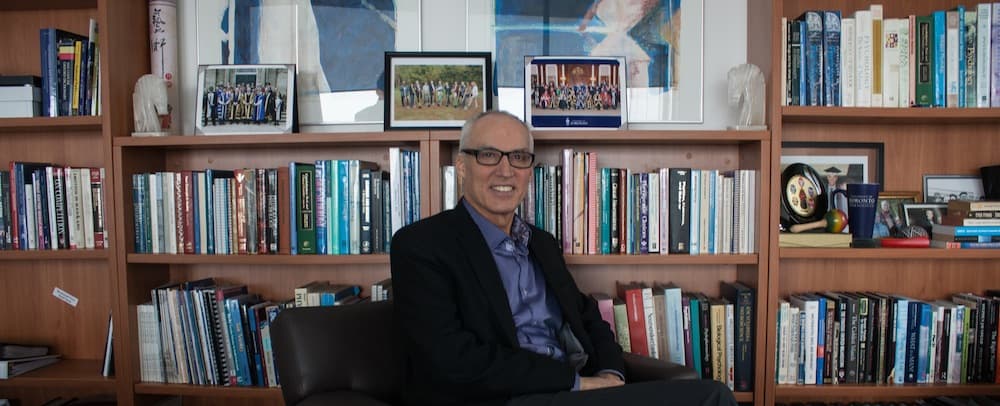The University of Toronto Scarborough has gone through immense changes in the past decade, and Franco Vaccarino has been at the helm of UTSC for much of that time. He has been the principal of the campus since 2007, and began his career at U of T in 1984. On January 21, it was announced that Vaccarino would be leaving this summer to become the new president of the University of Guelph. The Varsity sat down with Vaccarino to discuss the transformations, challenges, achievements, and future of UTSC.
The Varsity: The three U of T campuses are very different places. What makes UTSC unique, especially in comparison with its sister campuses?
Franco Vaccarino: There is a difference. It’s a parkland environment that is absolutely breathtaking at many times during the year. There are elements of our community that contribute to the difference, for example our partnership with the Toronto Zoo through our conservation biology programs. Part of it is also age. We are celebrating our fiftieth anniversary this year. St. George Campus has a long, proud history, and while I think that there are wonderful things that come with tradition, the youthfulness is an important part of the feeling of UTSC.
TV: Can you comment on some of the changes UTSC has gone through over the past decade or so?
FV: We went from five to 10 thousand students in a relatively short period of time. When I arrived, it was an opportunity to refine that growth and to think about our identity. A big part of the vision for UTSC was to create an intellectual and cultural hub in the eastern GTA. Out of that came things like the PhD program in environmental sciences, housed here at UTSC. It’s the first PhD program created at U of T housed somewhere other than the St. George campus, and I do believe it is symbolic of the trajectory that both UTSC and UTM are going to take in the future. What you see now is students coming out of high school and really looking at all three campuses.
TV: UTSC has also gone through a lot of challenges related to that growth. Here is something you said to the Toronto Star in 2010: “We had students writing exams on weekends because there weren’t enough rooms during the week. Some classes are held in portables. We have study carrels in the halls. We have dance troupes practicing in the lobby in front of the elevator.” So how do you face that challenge?
FV: When I look at that quote I actually see something enormously positive. It was actually very cool. I could walk in the front doors and there’d be some dance troupe in front of the elevator. My thought process was ‘Wow! Here we have this positive energy despite the physical restrictions.’ There was this community sense of wanting to do all sorts of things, but we were physically restricted. You might think it is just buildings and mortar, but it was becoming a barrier for us. So that was job one.
The portables that came on site were a release valve, but they also, more importantly, showed how bad things were. They were a wonderful photo-op for when reviewers in the provincial system would visit.
It was a very tough time. The economy had gone through one of the worst downturns in recent history. But during that, it was important to me that we forge ahead with plans, that we be prepared. We put together a master plan for this campus when some might have wondered how realistic that was, but it was about the future and about hope. Sure enough, the federal government introduced the Knowledge Infrastructure Program as stimulus funding, and we were ready. That gave rise to the Instructional Centre, a $70 million, state of the art building, and a huge release valve.
Shortly after that came the Pan American Games. One of the first messages I got from students was that our athletic facility was so sub-par. Finding funds for that is a challenge because it is not the core business, hence the referendum on funding that the students supported. I don’t think I thought we’d end up with two Olympic sized pools; the idea was to get a decent athletic facility. What I like about what happened there is it has connected us with the community.
TV: Both a challenge for UTSC, and in a broader sense a challenge for Scarborough, is the issue of inadequate transit and transportation.
FV: Absolutely. Let me comment on transit. This has been at the very top of our priorities. We are of course going to do everything possible to take advantage of the upcoming Pan Am games. The reality is that though a very important stakeholder, we are only one of the stakeholders. There had been a proposal that involved the LRT coming straight here, and now that has changed. The most important thing we can do, and we do this all the time, is to continue to remind government at all levels of the importance of UTSC. We continue to look at interim solutions. I do hope that over the next year or two, we get a master plan type solution, and I am confident that it will happen.
TV: We’ve been talking about the experience at UTSC, but I do want to ask you about becoming president of Guelph University.
FV: I’ve been part of U of T for thirty years, and I didn’t take the decision to go to Guelph lightly. I was approached about my interest, and the more I looked, the more it felt like a good fit. Part of that is because UTSC is in a strong position to move forward. We’ve done such amazing things here, it’s a huge element of pride, and it’s been a privilege for me to serve this community.


